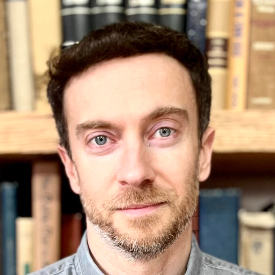Eliot Stein is a journalist and editor at BBC Travel. His book is inspired by his BBC column, “Custom Made,” in which he profiles people upholding ancient traditions. His work has appeared in the New York Times, Wired, The Washington Post, National Geographic, The Independent, and elsewhere.
What’s the big idea?
The world is losing cultural marvels at an alarming pace. From centuries of tradition, languages, and specialized craft, we are seeing a homogenization of culture. With each lost custom, we lose a unique way of seeing the world. The custodians of ancient skills and knowledge are custodians of the diverse wonders and rich perspectives humans can offer.
Below, Eliot shares five key insights from his new book, Custodians of Wonder: Ancient Customs, Profound Traditions, and the Last People Keeping Them Alive. Listen to the audio version—read by Eliot himself—in the Next Big Idea App.

1. Culture is a community’s way of understanding the world.
The languages we speak, the foods we eat, and the beliefs we hold are expressions of a community’s unique worldview. The Pirahā people of Brazil have no past or future tense because its speakers claim to exist solely in the present. The Fore tribe in Papua New Guinea believes you gain the wisdom of the animals you eat. And the Igorot peoples of the Philippines suspend their dead off the side of a cliff so the departed can be closer to the heavens. Individually, each of these cultural elements reflects a vision of what it means to be human. Together, they remind us how stunningly diverse the world is.
Yet, one of the most revealing ways of understanding a community’s distinct vision of the world is by studying the ancient customs and traditions they continue to maintain—especially when they no longer serve a practical purpose. Five hundred years after the Inca Empire’s collapse, what compels 1,100 people from four villages to come together every year and risk their lives to dangle a grass-woven bridge over a rushing river when a modern steel one exists just a few steps away? Or craftsmen in India to toil for five days in the heat to produce a sacred metal mirror when cheaper glass ones are available on Amazon? Or a lone night watchman in Sweden to climb 110 steps to the top of a church tower to scan the darkness for fires and danger when smoke alarms and security cameras can see everything?
These gorgeous, irrational, gentle things humans do are what make the world so inexorably fascinating. Culture is born slowly through a million tiny moments, and each of these unique wonders reminds us of where we came from, what we believe in, and who we are.
2. We’re experiencing “local extinction.”
When localism gives way to internationalism, we often lose the distinct vestiges that make our world so wonderfully diverse. This global homogenization is happening before our eyes. Nine languages disappear every year. By 2080, that annual rate is expected to jump to 16, and if we don’t do anything to halt this linguistic loss, more than half of the world’s languages will be extinct in the next 100 years. More than 6,000 foods and culinary practices are on the brink of disappearance. Nearly 3,000 villages in Spain are at risk of becoming ghost towns; 2,500 in Italy are perilously depopulated; and 896 towns and villages across Japan are estimated to disappear by 2040 as better-paying jobs lure young people to cities—a phenomenon the country’s former minister for internal affairs described as “local extinction.”
“Nine languages disappear every year.”
As people increasingly speak the same languages, live in the same cities, eat the same foods, and adhere to the same customs, we’re becoming a more homogenous species. None of this bodes well for those who travel to be stirred by the unfamiliar and enthralled by the boundless depths of how the natural world affects human expression. Nor does it for the endangered artisans and final custodians preserving knowledge that would otherwise fade away. In many ways, these guardians are the closest thing we have to humanity’s wise men and women. While culture is an ever-evolving force, what’s at risk of being lost with their disappearance is nothing less than the world’s local, whimsical soul.
3. We’re pricing out cultural heritage.
Many factors are causing local extinction, including rapid globalization, technological advances, increased ease of travel, and (above all) economics. Simply put, there isn’t enough money in most of these ancient customs to make a living today. As the heir to the world’s rarest pasta—the “threads of God”—told me: “You can’t earn a living making su filindeu. There’s no future in it.” As a result, many young people abandon age-old rites passed down within their families for generations in favor of more lucrative jobs.
When these threads that have bound generations together begin to unravel, a certain mastery disappears with it. We collectively lose something. From a 15th-generation Inca bridge builder to a 27th-generation West African griot to an unbroken line of women whose needle-thin pasta has united an island for centuries, these families have given something special to a place—a certain knowledge, a skill—and in doing so, helped shape its identity. But because the specific thing that each custodian embodies is often a reflection of a larger community’s unique worldview, this makes these quiet deaths doubly tragic: not only do we lose someone who has dedicated their whole life to mastering a specific artistry, we also lose a different way of understanding the world. When one of these seemingly insignificant wonders fades away, an irretrievable part of our humanity vanishes with it.
4. Custodians are inseparable from their craft.
Whether the custom these keepers maintain is 100 or 1,000 years old, every custodian I’ve met is inseparable from their craft. Roland Borg, Europe’s last medieval night watchman, told me that guarding the town he loves from high up in a church bell tower isn’t his job; it’s who he is. Yasuo Yamamoto, a brewer preserving the secret ingredient in Japan’s 700-year-old original soy sauce recipe, revealed that over time, every barrel of soy sauce takes on the personality of the person who creates it. And Yan Jhen-fa, Asia’s last film poster painter who uses deft brushstrokes to create startlingly realistic billboards and then climbs up the side of buildings to hang them on theatre marquees, told me that without this craft, “there would be no me.”
“Every custodian I’ve met is inseparable from their craft.”
Spending a week shadowing a third-generation night watchman or a fourth-generation soy sauce brewer may seem like an unusual way to make sense of the world, but it is as generous a teacher as I could ever ask for. These sentinels have entrusted me with more than their stories. They have shown me their process, revealed their most intimate joys and sorrows, and explained what inspires them to carry on. After profiling so many people whose only wish is that the tradition they’ve devoted themselves to be passed on to their children, I’ve come to understand that one of the greatest uses of life is to spend it on something that will outlast it.
5. The world can still be a wondrous place.
In an age when everything has seemingly been explored and explained, and where cynicism often overshadows curiosity and wonder, these customs and custodians remind us how much there still is to discover and invite us to fall back in love with the world.
Sometimes, when I find myself doom-scrolling and feeling sad about the state of the world, I close my eyes and remember that for the last 800 years, a single family in rural Guinea has been guarding a mythical instrument revered by 11 million people across West Africa that’s believed to have been born from a genie. Or that in the rural reaches of England, a woman carries on the ancient rite of softly whispering the most intimate details of her life to her colony of bees out of trust and devotion. Or that deep in a forest in northern Germany, a lone postman has been crunching through the woods every day for decades to deliver letters from hopeless romantics to the only tree in the world with its own mailing address—and that this 500-year-old oak tree is now responsible for more than 100 marriages.
These may sound like far-fetched fairy tales or gilded fables, but they remind me that we humans are what we believe, and the world is always so much richer than our ideas of it.
To listen to the audio version read by author Eliot Stein, download the Next Big Idea App today:
































